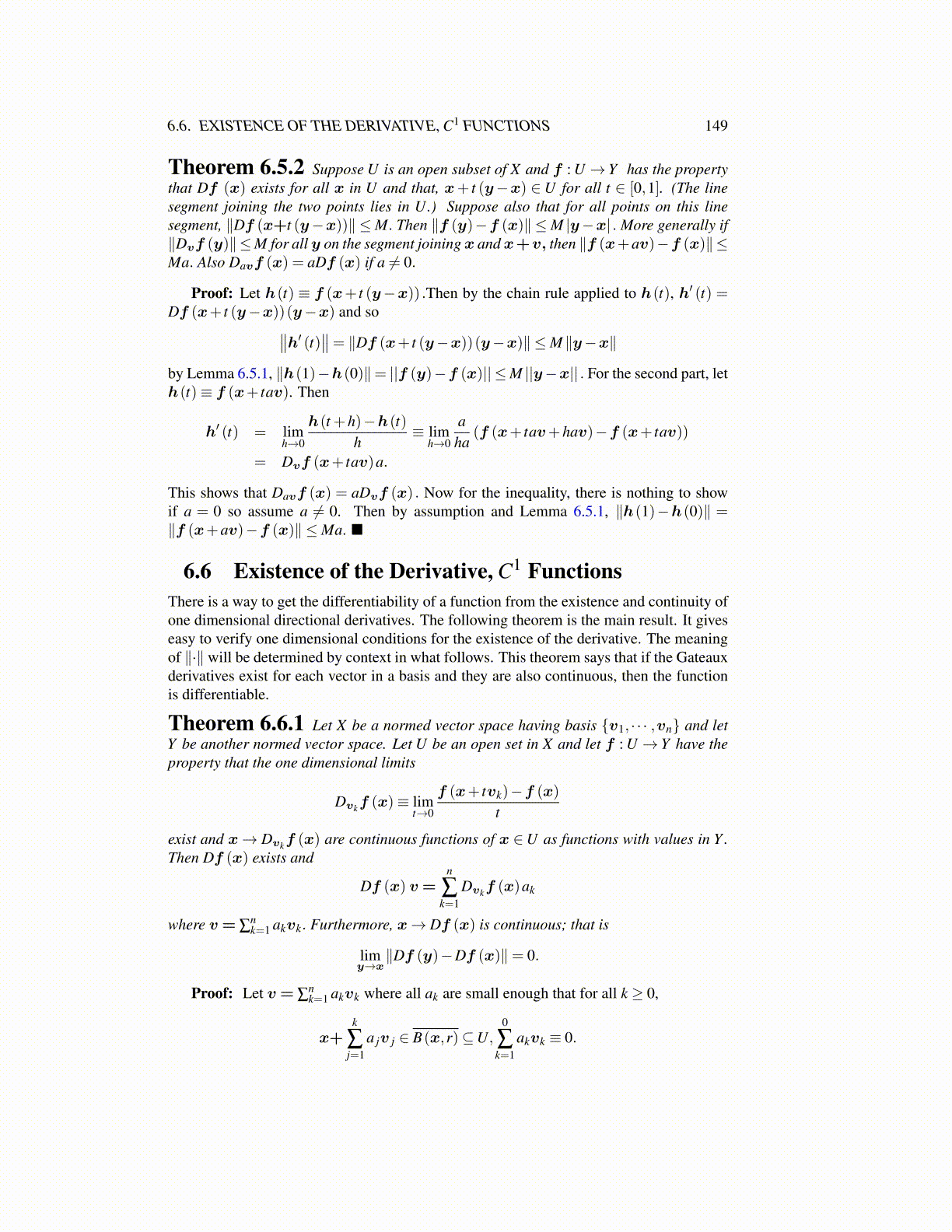
6.6. EXISTENCE OF THE DERIVATIVE, C1 FUNCTIONS 149
Theorem 6.5.2 Suppose U is an open subset of X and f : U → Y has the propertythat Df (x) exists for all x in U and that, x+ t (y−x) ∈U for all t ∈ [0,1]. (The linesegment joining the two points lies in U.) Suppose also that for all points on this linesegment, ∥Df (x+t (y−x))∥ ≤M. Then ∥f (y)−f (x)∥ ≤M |y−x| . More generally if∥Dvf (y)∥≤M for all y on the segment joining x and x+v, then ∥f (x+av)−f (x)∥≤Ma. Also Davf (x) = aDf (x) if a ̸= 0.
Proof: Let h(t) ≡ f (x+ t (y−x)) .Then by the chain rule applied to h(t), h′ (t) =Df (x+ t (y−x))(y−x) and so∥∥h′ (t)∥∥= ∥Df (x+ t (y−x))(y−x)∥ ≤M ∥y−x∥
by Lemma 6.5.1, ∥h(1)−h(0)∥= ||f (y)−f (x)|| ≤M ||y−x|| . For the second part, leth(t)≡ f (x+ tav). Then
h′ (t) = limh→0
h(t +h)−h(t)h
≡ limh→0
aha
(f (x+ tav+hav)−f (x+ tav))
= Dvf (x+ tav)a.
This shows that Davf (x) = aDvf (x) . Now for the inequality, there is nothing to showif a = 0 so assume a ̸= 0. Then by assumption and Lemma 6.5.1, ∥h(1)−h(0)∥ =∥f (x+av)−f (x)∥ ≤Ma. ■
6.6 Existence of the Derivative, C1 FunctionsThere is a way to get the differentiability of a function from the existence and continuity ofone dimensional directional derivatives. The following theorem is the main result. It giveseasy to verify one dimensional conditions for the existence of the derivative. The meaningof ∥·∥ will be determined by context in what follows. This theorem says that if the Gateauxderivatives exist for each vector in a basis and they are also continuous, then the functionis differentiable.
Theorem 6.6.1 Let X be a normed vector space having basis {v1, · · · ,vn} and letY be another normed vector space. Let U be an open set in X and let f : U → Y have theproperty that the one dimensional limits
Dvkf (x)≡ limt→0
f (x+ tvk)−f (x)
t
exist and x→ Dvkf (x) are continuous functions of x ∈U as functions with values in Y .Then Df (x) exists and
Df (x) v =n
∑k=1
Dvkf (x)ak
where v = ∑nk=1 akvk. Furthermore, x→ Df (x) is continuous; that is
limy→x∥Df (y)−Df (x)∥= 0.
Proof: Let v = ∑nk=1 akvk where all ak are small enough that for all k ≥ 0,
x+k
∑j=1
a jv j ∈ B(x,r)⊆U,0
∑k=1
akvk ≡ 0.